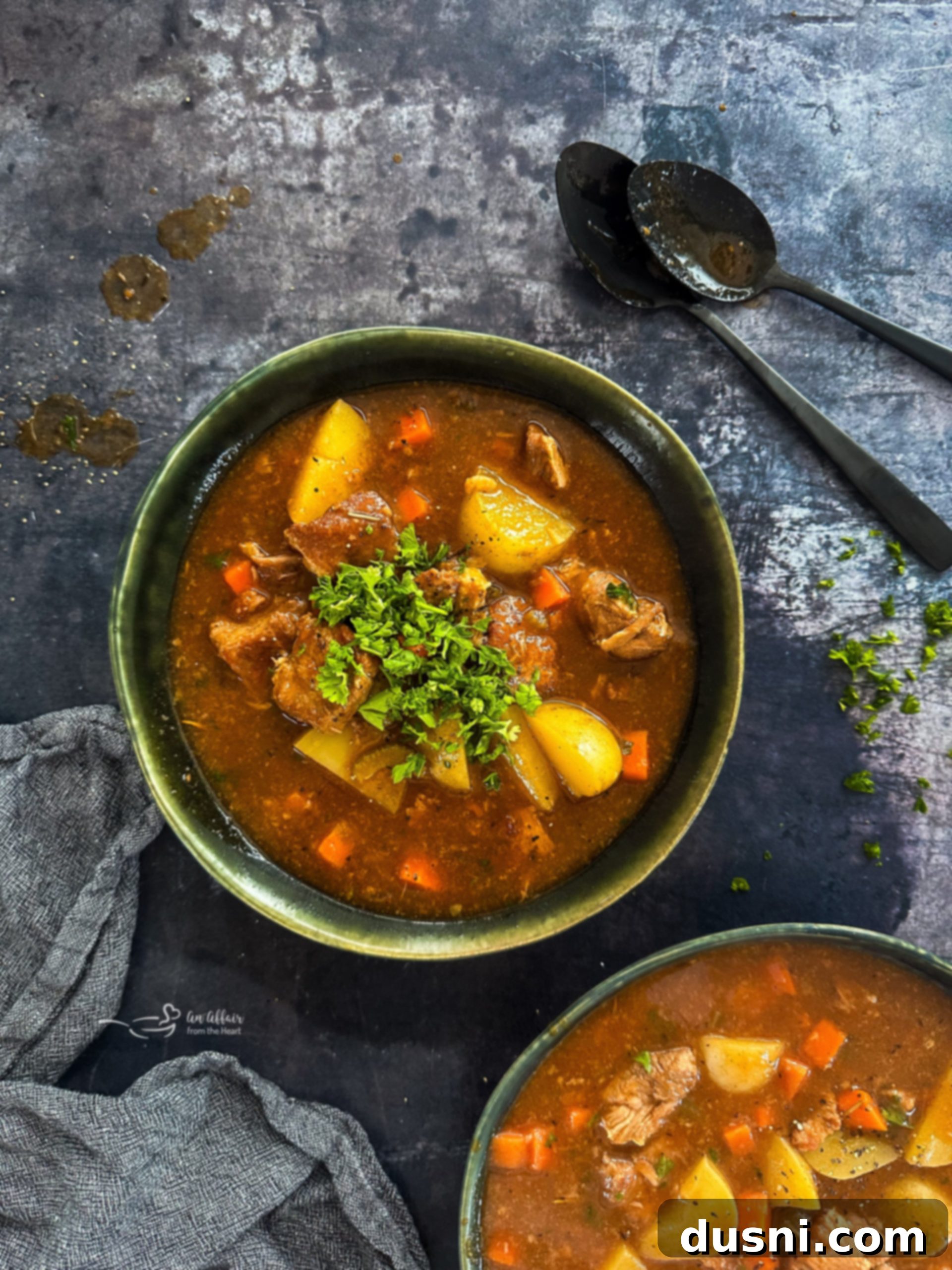Hearty & Flavorful Pork Stew: Your Ultimate Comfort Food Recipe
There’s an undeniable magic to a bubbling pot of homemade pork stew, especially on a crisp, chilly evening. The comforting aroma that fills your home is just the beginning of this culinary journey. Each spoonful promises a delightful combination of succulent, fork-tender pork chunks, perfectly cooked vegetables, and a rich, deeply flavorful broth that warms you from the inside out. This classic cozy meal, crafted with simple, wholesome ingredients and the beauty of slow cooking, is elevated by just the right blend of herbs and spices, creating a depth of flavor reminiscent of traditional stews that will have your family asking for it again and again.
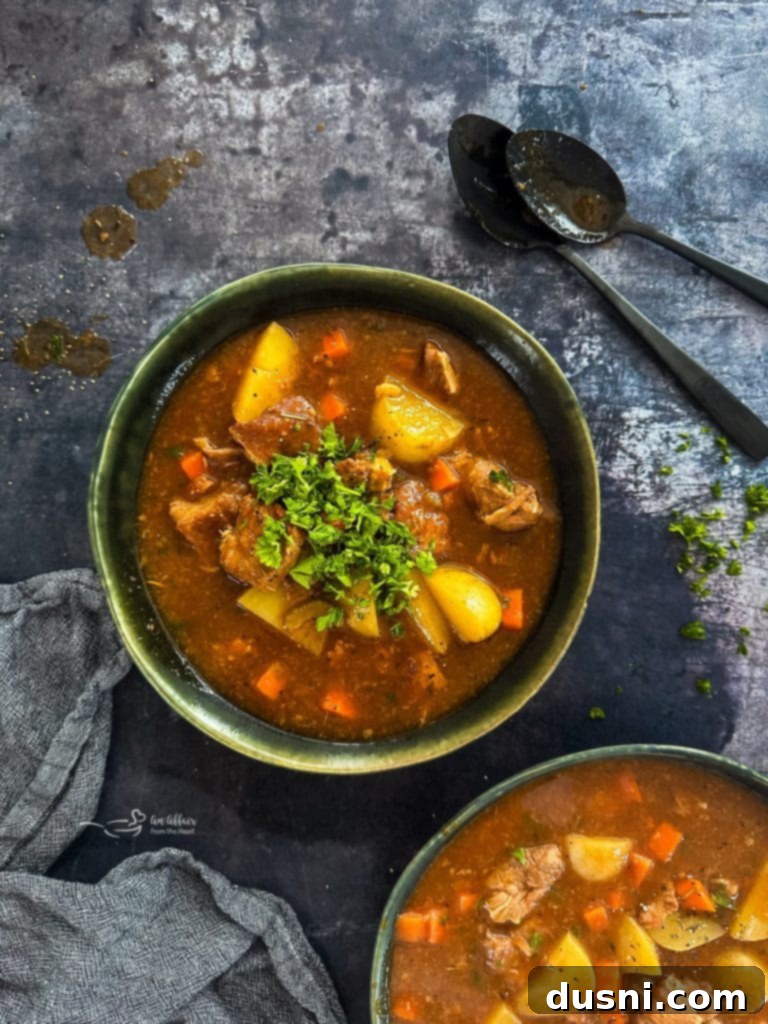
As the “ber months” (September, October, November, and December) roll in, signaling the arrival of cooler weather, my thoughts naturally turn to comforting, warming dishes. These are some of my favorite months of the entire year, and there’s no better way to embrace them than with a robust, nourishing recipe like this one. You know me – soups and stews are my ultimate comfort foods. While I could happily enjoy a piping hot bowl even on a warm patio, many prefer to wait until the days shorten and temperatures drop before indulging in these hearty delights. This pork stew is designed to be your perfect companion through the autumn and winter seasons, offering warmth, satisfaction, and incredible flavor.

Why Pork Shoulder is the Best for Stew
For a truly exceptional stovetop stew, pork shoulder – often referred to as pork butt or Boston butt – is undeniably the best choice. This cut is rich in connective tissue and marbling, which, while making it tough for quick cooking, transforms magnificently under a slow, moist heat. During the extended cooking process, this connective tissue slowly breaks down into gelatin, infusing the broth with incredible body and flavor, and leaving you with melt-in-your-mouth, fork-tender pieces of meat. It’s a cut that rewards patience with unparalleled richness and a texture that defines a perfect stew.
While other options like pork loin or pork tenderloin *can* be used in a pinch, they are significantly leaner. This means they won’t yield the same deep richness or develop the same succulent tenderness as pork shoulder, making them less ideal for this specific, slow-cooked stew method. No matter your choice, pork stew meat is celebrated for its versatility and affordability, making it a family favorite. The exceptional quality of pork available to us, thanks to the dedicated Iowa pork farmers and producers across the USA, makes crafting delicious, hearty recipes like this one possible and accessible to every home cook.
Iowa Pork proudly sponsors this post, and all opinions, along with my lifelong passion for pork recipes and Iowa Pork products, are entirely my own.
Crafting the Ultimate Pork Stew: Simple & Flavorful
What I cherish most about this pork stew recipe is its remarkable approachability. It’s designed for home cooks of all skill levels, utilizing everyday staple ingredients and a straightforward cooking process. The journey begins on the stovetop in a large Dutch oven, where you’ll brown the meat, a crucial step for building foundational flavor. Once browned, the beauty of slow cooking takes over, allowing the flavors to meld and deepen over time. The bottom of the pot, laden with browned bits of meat (known as ‘fond’), is then deglazed and incorporated into the stew with tomato sauce, fresh garlic, and other ingredients, adding an unparalleled depth that a quick stew simply cannot achieve. While I personally love the consistent heat and even cooking of a Dutch oven, this versatile recipe can also be effortlessly adapted for a slow cooker, offering flexibility for your busy schedule.

Understanding Pork Shoulder Roast for Stews
Pork shoulder roast, a prized cut for many comfort food recipes, originates from the upper part of the pig’s front leg, situated just above the foreleg. Its generous marbling of fat and abundance of connective tissue make it exceptionally well-suited for cooking methods that involve low and slow heat, such as braising, roasting, or, in this case, stewing. This is precisely why it’s the star of our hearty pork stew.
When you’re at the grocery store, don’t be surprised to see pork shoulder labeled as “pork butt” or “Boston butt,” despite the misleading name suggesting it comes from the animal’s rear. These terms are historical and refer to the way the meat was traditionally butchered and packed. Pork shoulder roast is commonly sold in both bone-in and boneless varieties, both of which perform beautifully in slow-cooked dishes. The magic of this cut lies in its ability to transform: as it cooks slowly, the fat melts, basting the meat, and the connective tissues break down into gelatin, resulting in incredibly tender, juicy meat. For barbecue, it’s often cooked until it reaches an internal temperature of approximately 190–205°F, allowing it to be easily pulled apart. When served as a sliced roast, 145°F is the target. For a stew, however, you’ll know your pork is perfectly cooked when it’s effortlessly fork-tender and breaks apart into succulent, juicy chunks with minimal resistance. This transformation is key to the irresistible texture of a truly great pork stew.
If you’ve enjoyed this recipe, I highly recommend exploring my other beloved pork dishes, such as my Pork Roast and Gravy and my speedy Instant Pot Dr. Pepper BBQ Pork Ribs recipe. They showcase the incredible versatility of pork!
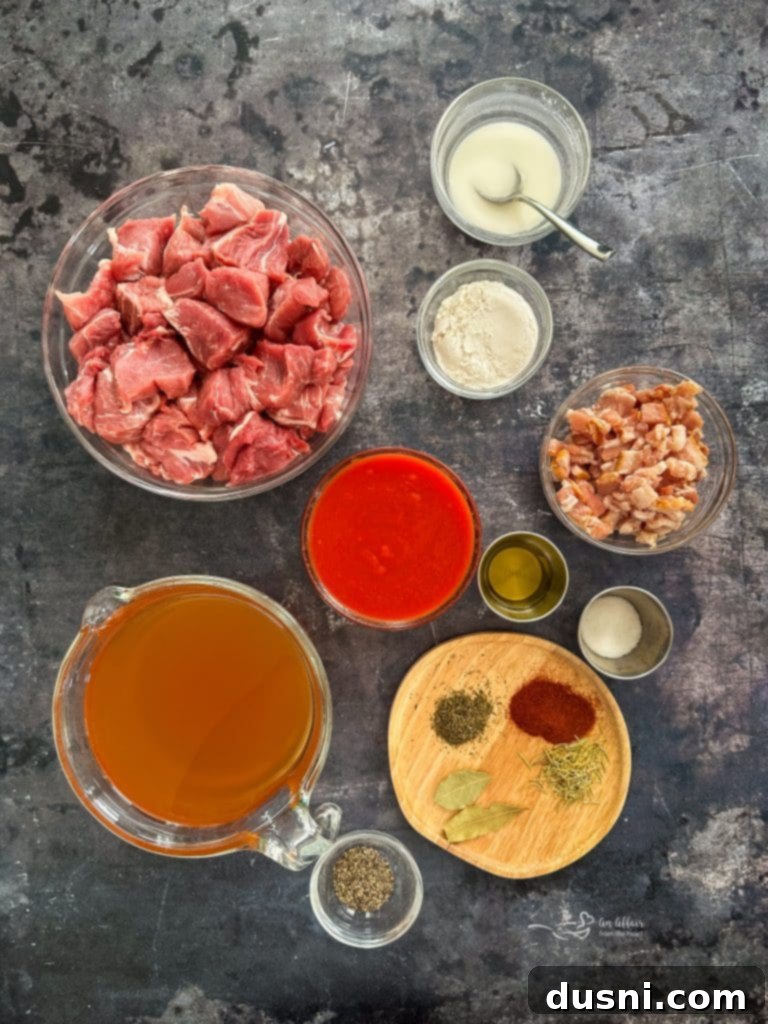
Essential Ingredients for a Flavorful Pork Stew
Gathering the right ingredients is the first step to a truly memorable pork stew. Below is a detailed list of what you’ll need, along with helpful tips and potential substitutions. All precise measurements and step-by-step instructions can be found in the printable recipe card at the very bottom of this post.
- Thick-cut Bacon: This isn’t just for flavor; it provides a crucial smoky base and renders delicious fat, which we’ll use to brown the pork, adding incredible depth right from the start.
- Pork Shoulder Roast (Boston Butt): The undisputed star of our stew. Its generous marbling and connective tissue are ideal for slow cooking, yielding incredibly tender, juicy pork chunks. While pork loin, pork tenderloin, or even pork chops can be used in a pinch as alternative pork stew meat, remember that the shoulder will consistently deliver the richest flavor and most desirable texture.
- Salt and All-Purpose Flour: This simple dredging mixture is key. Coating the cubed pork pieces helps them achieve a beautiful golden-brown crust when seared, a process known as the Maillard reaction, which develops complex flavors. The flour also acts as a natural thickener for the stew later on, contributing to a rich, silky broth.
- Olive Oil: Used for sautéing the aromatic vegetables, ensuring they soften and release their sweet, savory notes without burning. It helps bring all the initial flavors together harmoniously.
- Tomato Sauce: A foundational ingredient that helps build a robust, slightly tangy gravy. Its acidity brightens the stew while its richness adds body and a subtle sweetness that complements the pork beautifully.
- Bay Leaves, Dried Thyme, Dried Rosemary, and Paprika: These are the classic, aromatic powerhouses that define the comforting flavor profile of a traditional stew. Bay leaves add an herbal depth, thyme brings earthy notes, rosemary contributes a woody, pine-like aroma, and paprika offers a mild, sweet pepperiness. For an extra layer of flavor or a bit of a kick, consider smoked paprika or a teaspoon of red pepper flakes.
- Vegetable Stock: This liquid base ensures the flavors remain balanced and vibrant. Feel free to use chicken broth, chicken stock, or beef broth if that’s what you have on hand; they will all work wonderfully to create a rich stew.
- Cornstarch Slurry: This simple mixture of cornstarch and water is whisked in at the end of cooking to perfectly thicken the stew into a luxurious, clingy gravy. A small amount of all-purpose flour mixed with water can serve as an effective substitute if cornstarch is unavailable.
- Black Pepper: Essential for adding a pleasant warmth and a touch of subtle spice, enhancing the overall savory profile of the stew.
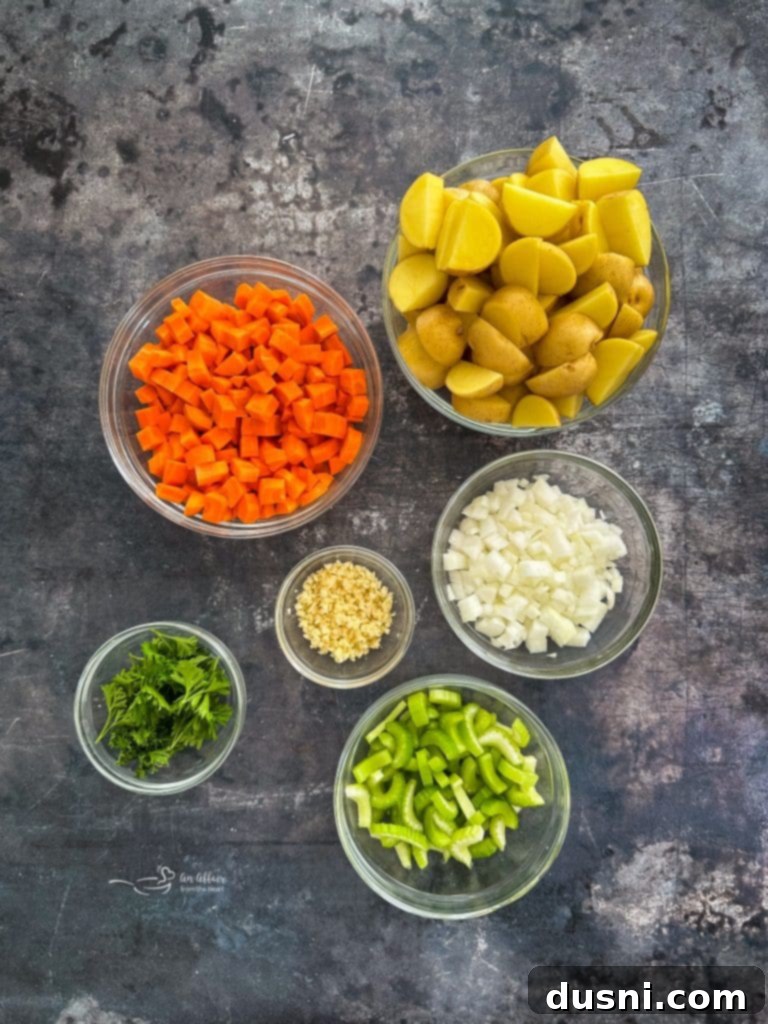
- Yukon Gold Potatoes: These potatoes are an excellent choice because they hold their shape well during slow cooking and develop a wonderfully buttery, tender texture. Russet potatoes or sweet potatoes can also be used, offering slightly different textures and flavor profiles.
- Yellow Onion and Celery: These are part of the “mirepoix” (or “holy trinity” in some cuisines), forming the foundational aromatic base for the stew. Sautéing them releases their natural sweetness and savory compounds, building a complex flavor background.
- Carrots: Adding a natural sweetness and vibrant color, carrots provide a hearty texture that perfectly balances the rich flavors of the broth and tender pork.
- Fresh Garlic: Minced fresh garlic is indispensable, infusing the broth with its pungent, aromatic intensity and bringing out a profound depth of flavor that dried garlic simply can’t replicate.
- Fresh Parsley: A bright and refreshing garnish that adds a pop of color and a clean, herbaceous finish to the rich stew. Other fresh herbs, such as fresh rosemary or thyme sprigs, can also be sprinkled on before serving for an extra layer of aroma.

Step-by-Step: How to Make This Irresistible Pork Stew
Once you’ve completed your initial chopping and preparation, this comforting pork stew comes together surprisingly quickly and easily. Get ready for your kitchen to fill with the most incredible aromas, signaling a delicious meal to come!
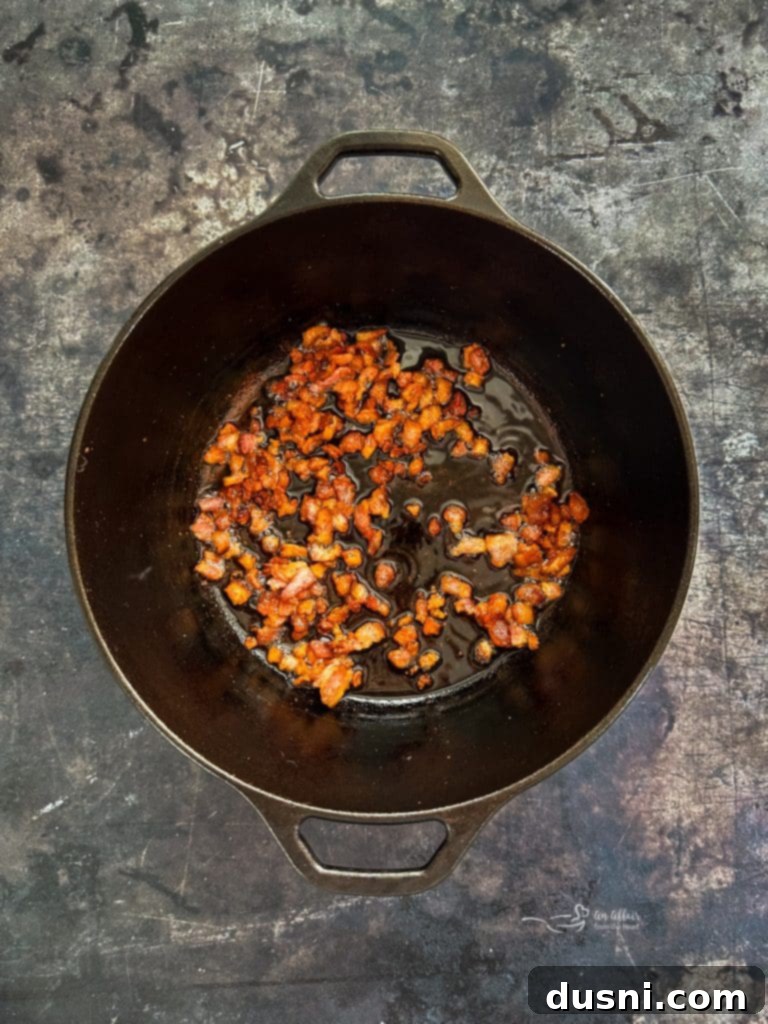
1. Crisp the Bacon: Begin by adding the chopped thick-cut bacon to a large Dutch oven. Set it over medium-high heat and cook, stirring occasionally, until the bacon becomes beautifully golden and crispy, and its fat has fully rendered. This initial step not only gives us flavorful bacon bits but also creates a flavorful cooking fat for the next stage. Carefully transfer the crispy bacon to a paper-towel-lined plate, reserving the delicious drippings in the pot.

2. Prepare and Sear the Pork: In a shallow dish, combine the all-purpose flour and salt. Thoroughly dredge the cubed pork shoulder pieces in this mixture, ensuring each piece is evenly coated. This coating is vital for achieving a fantastic crust and contributes to the stew’s eventual thickness. Next, working in batches to avoid overcrowding (which would steam the meat instead of searing it), add the coated pork to the pot with the reserved bacon fat. Sear the pork on all sides until it develops a deep, golden-brown crust. This browning is critical for developing rich, savory flavors through the Maillard reaction. Once browned, transfer the pork to the plate with the crispy bacon. If there’s excess fat, carefully drain it, but leave any browned bits (‘fond’) in the pot.
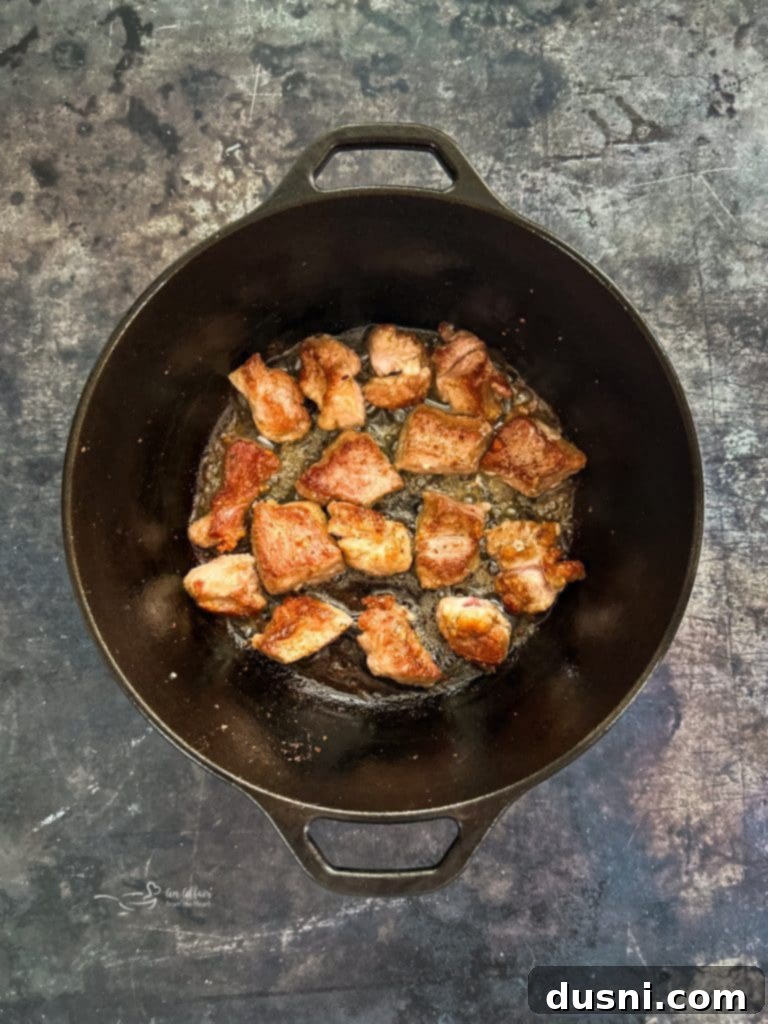
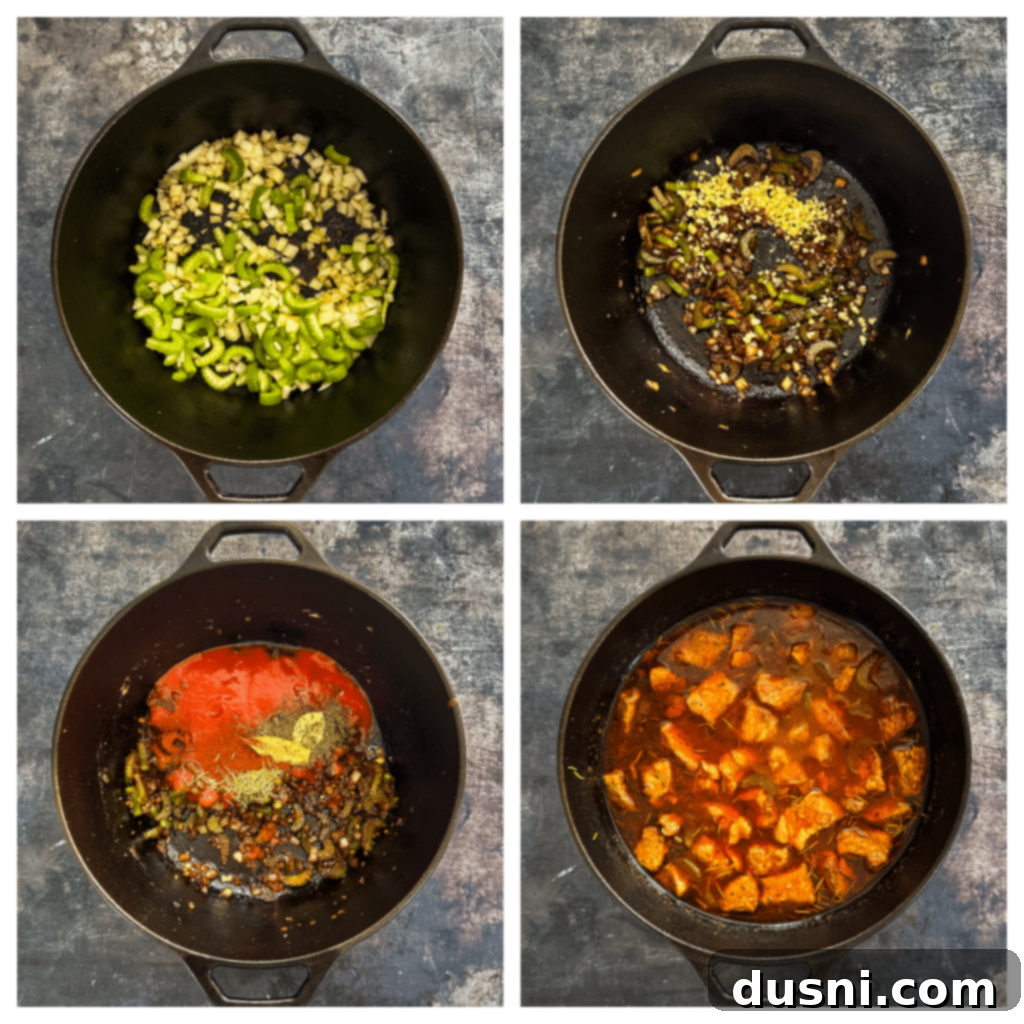
3. Build the Flavor Base: Add a splash of fresh olive oil to the pot (if needed) and reduce the heat to medium. Sauté the diced yellow onion and celery, stirring frequently, until they become translucent and tender. This takes about 5-7 minutes. Stir in the minced fresh garlic and cook for just about 1 minute more, until it becomes wonderfully fragrant – be careful not to let it burn. Pour in the tomato sauce, then add the bay leaves, dried thyme, dried rosemary, and paprika. Crucially, use a wooden spoon to scrape up all those flavorful browned bits (the ‘fond’) from the bottom of the pot. These bits are concentrated flavor and will dissolve into your stew, adding incredible depth.
4. Simmer to Perfection: Return the browned pork and crispy bacon to the pot. Pour in the vegetable stock, ensuring the meat is mostly submerged. Bring the mixture to a gentle boil over high heat, then immediately reduce the heat to low to maintain a bare simmer. Cover the Dutch oven tightly and let it cook patiently for approximately 90 minutes. During this slow simmer, the pork will undergo a magical transformation, becoming incredibly fork-tender as its connective tissues break down. Stir occasionally to prevent sticking and ensure even cooking.
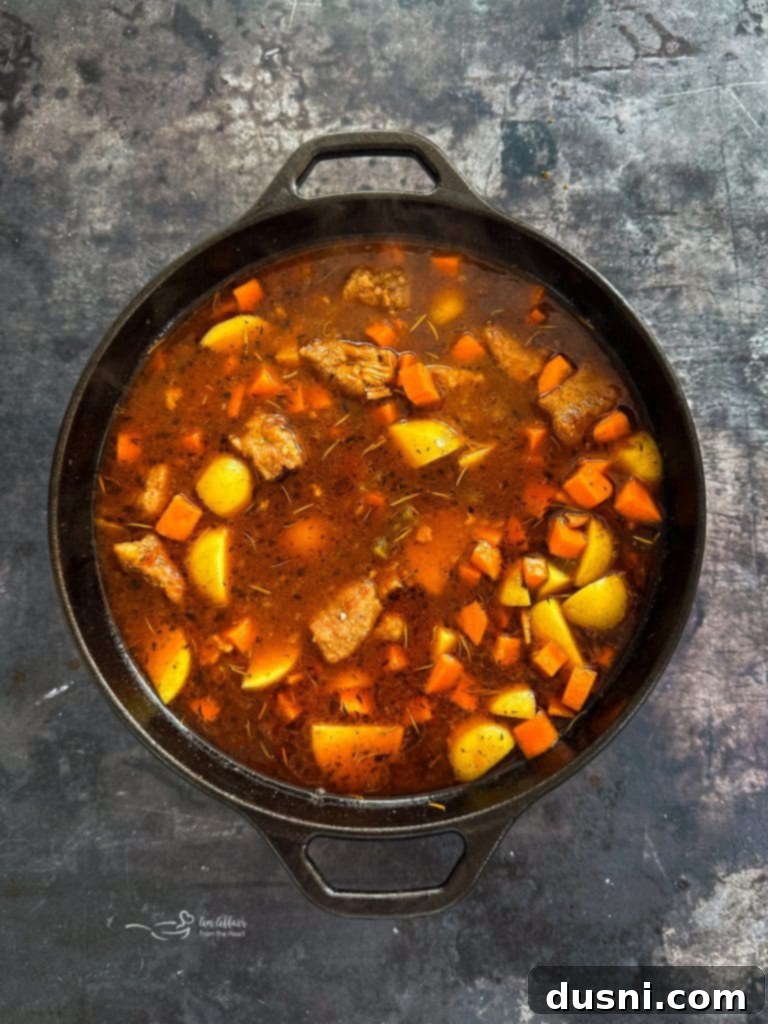
5. Add Vegetables & Thicken: Uncover the pot and stir in the chopped carrots and Yukon gold potatoes. Cover again and continue simmering for about 30 minutes, or until the vegetables are tender when pierced with a fork. Once the vegetables are cooked, carefully remove and discard the bay leaves. In a small bowl, whisk together the cornstarch and water to create a smooth slurry. Pour this slurry into the simmering stew, stirring continuously. Cook for an additional 5 minutes, allowing the stew to thicken into a rich, luscious gravy. Finally, taste the stew and adjust the seasoning as needed with black pepper and more salt, ensuring it’s perfectly balanced to your liking.
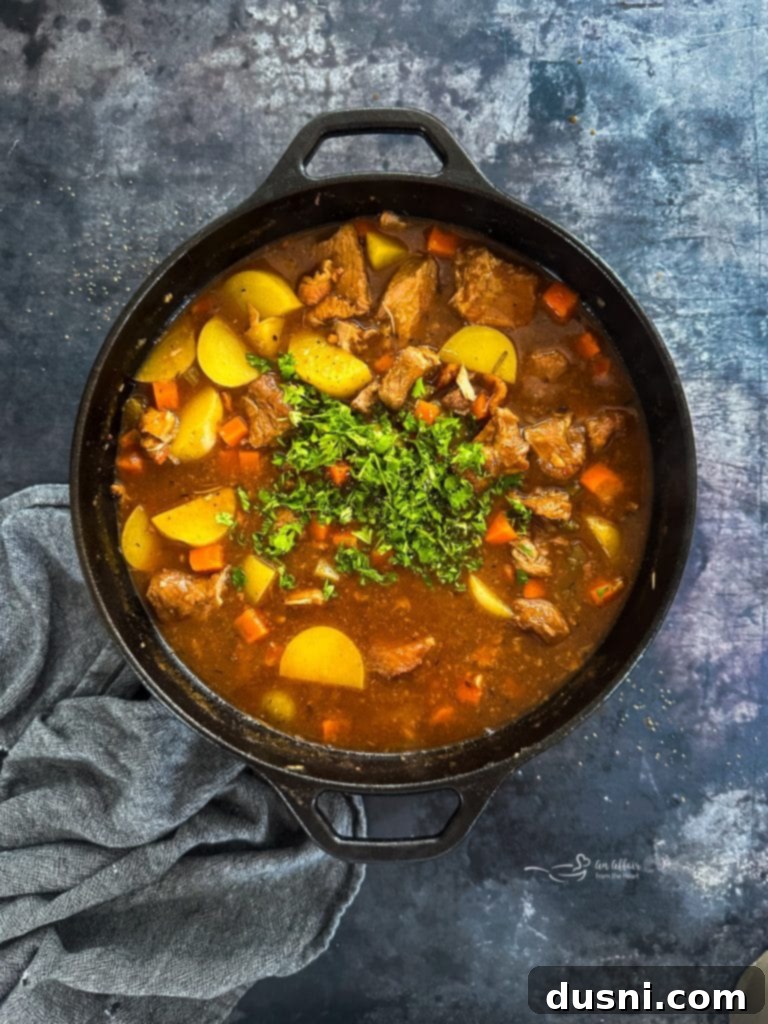
6. Serve & Enjoy: Ladle generous portions of the hot, fragrant pork stew into individual bowls. Garnish generously with freshly chopped parsley for a burst of freshness and color. This hearty meal pairs wonderfully with a side of crusty Dutch oven bread, perfect for soaking up every last drop of the rich gravy, or fluffy homemade buttermilk biscuits. For a complete meal, consider serving it alongside mashed potatoes, white rice, or even a light green salad to balance the richness.
Slow Cooker Adaptations for Your Pork Stew
For those days when you need a hands-off approach, this delicious pork stew can be easily adapted for a slow cooker. The slow cooker method is fantastic for busy weeknights, allowing the flavors to meld beautifully while you go about your day.
- Pre-Cook Your Meat & Bacon: Even with a slow cooker, the initial browning steps are crucial for flavor development. Follow the stovetop instructions to brown the pork shoulder and crisp the bacon as you normally would before transferring them to your slow cooker insert. This extra step ensures a depth of flavor that purely “dump-and-go” slow cooker recipes often miss.
- Combine Ingredients: Once the pork and bacon are browned, add them to the slow cooker. Then, add all the remaining ingredients listed in the recipe (except for the fresh parsley, which is best added at the end) into the slow cooker pot. Give everything a good stir to combine.
- Slow Cook to Tenderness: Cover the slow cooker and cook on the LOW setting for 7–8 hours, or on the HIGH setting for 3½–4 hours. The goal is for the pork to be incredibly fork-tender and the vegetables to be perfectly cooked through. Cooking times can vary based on your slow cooker’s model and temperature, so check for tenderness.
- Final Touches: Approximately 5-10 minutes before you’re ready to serve, stir in the cornstarch slurry to thicken the stew to your desired consistency. Taste the stew and adjust the seasoning with salt and black pepper as needed. Just before serving, sprinkle generously with fresh parsley for a burst of fresh flavor and color.
Storage & Reheating Tips for Leftover Pork Stew
This pork stew is often even better the next day as the flavors continue to deepen and meld. Proper storage ensures you can enjoy your delicious leftovers safely.
- Refrigerator: Allow the stew to cool completely to room temperature before storing. Transfer it to an airtight container and refrigerate for up to 4 days. Storing it in smaller portions can help it cool faster and make reheating easier.
- Freezer: For longer storage, portion the cooled stew into freezer-safe containers or heavy-duty freezer bags. Be sure to leave a little room at the top for expansion if using containers. Freeze for up to 3 months. When you’re ready to enjoy, thaw the frozen stew overnight in the refrigerator for best results.
- Reheating: Gently reheat the stew on the stovetop over medium heat, stirring occasionally to ensure even warming and prevent sticking. If the stew has thickened too much during storage, add a splash of extra stock or water to achieve your preferred consistency. You can also reheat individual portions in the microwave, stirring halfway through, until thoroughly heated.
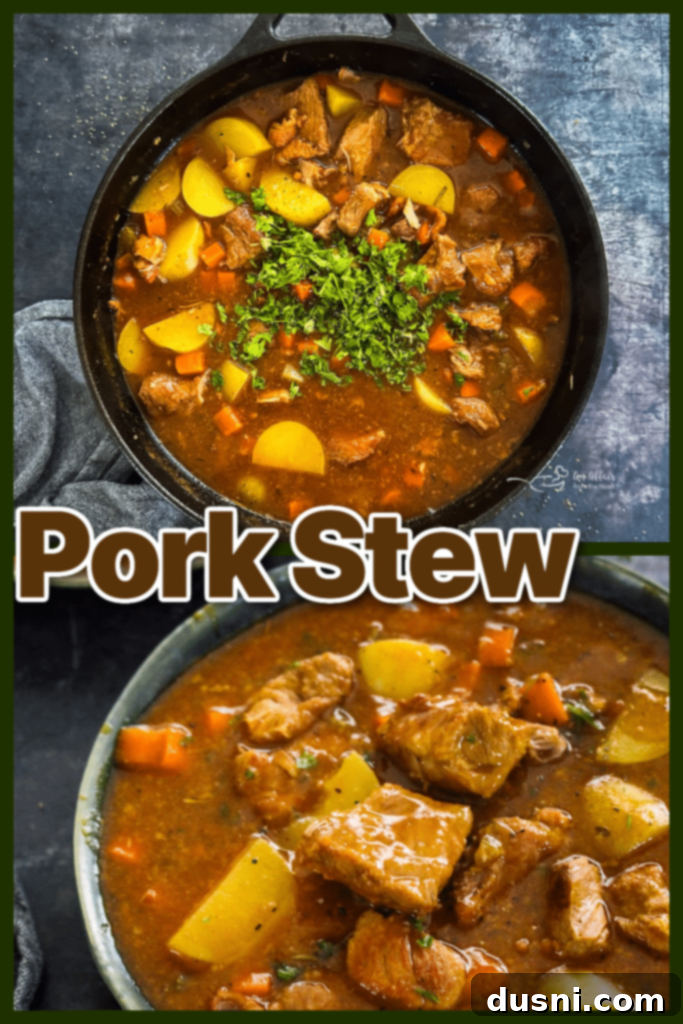
Love This Recipe? Pin It for Later!
If this mouth-watering Pork Stew recipe has captured your imagination and you’re eager to try it, make sure you can easily find it when you’re ready to cook! Pin it to your favorite Pinterest recipe board before you leave. Sharing is caring, and this recipe is definitely worth sharing!

Mastering the Internal Temperature of Pork
Pork’s incredible versatility means it can be prepared in countless ways, each highlighting different cuts and cooking methods. On my site, you’ll discover a wealth of pork recipes that celebrate this diversity. However, achieving perfect results hinges on understanding and reaching the ideal internal temperature for each specific cut. Thankfully, the experts at Iowa Pork have created a highly beneficial Pork Cooking Temperature Guide, making it simple for everyone to know precisely when their pork is cooked to perfection, ensuring both safety and optimal tenderness.
To accurately check for doneness, always use a reliable digital meat thermometer. Insert the thermometer into the thickest part of the pork cut, being careful to avoid touching any bone, as bone can conduct heat differently and give an inaccurate reading. Once the pork reaches its recommended internal temperature, remove it from the heat and allow it to rest for at least three minutes before slicing or serving. This resting period is crucial; it allows the juices to redistribute throughout the meat, resulting in a more succulent and flavorful final product. For pork stews, while the goal is fork-tenderness, ensuring the initial cooking of the pork chunks reaches a safe temperature (around 145°F, before the long simmer) is always a good practice.

Celebrating the Love of Pork and Iowa Farmers
While I may not have had the privilege of growing up on an Iowa farm like my husband, pork has always been a cherished staple at our family table. One of my fondest childhood memories centers around my mom’s comforting Pork Chops with Mushroom Gravy, a recipe I now frequently prepare for my own children. What they might not fully realize is that beyond savoring the delicious flavor, they are also benefiting from the exceptional nutritional benefits that pork provides. It’s a win-win, offering both incredible taste and valuable nutrients.
Did you know that approximately one-third of all pork raised in the United States originates from Iowa? And a significant portion of that high-quality pork is enjoyed right here in American homes. When you choose pork at your local grocery store, you are directly supporting dedicated family farms, not just in Iowa but throughout the entire United States. These farmers work tirelessly to provide safe, wholesome, and delicious pork, contributing to local economies and sustaining a vital agricultural heritage. It’s a wonderful feeling to know that enjoying a meal like this pork stew connects us to the hard work and passion of these American producers.

Discover More Delicious Pork Recipes
I have been incredibly fortunate to collaborate with Iowa Pork for many years, and together, we’ve brought countless wonderful recipes to life. Some of my personal favorites include my grandma’s comforting Instant Pot Ham & Bean Soup, the irresistible Sweet & Spicy Bacon Wrapped Pork Ribs, the unbelievably simple Fuggedaboutit Pork Roast, a rich Cream of Bacon Soup, and, of course, those incredibly yummy No Peek Pork Chops, beautifully pictured above. These recipes truly highlight the versatility and deliciousness of pork in various forms. You can explore all of my pork recipes right here on my website, a treasure trove of culinary inspiration for any pork lover.

For a continuous stream of delicious pork recipes and updates throughout the year, be sure to follow along with Iowa Pork on their various social media channels: Instagram, Facebook, Pinterest, and Twitter. They’re a fantastic resource for all things pork!
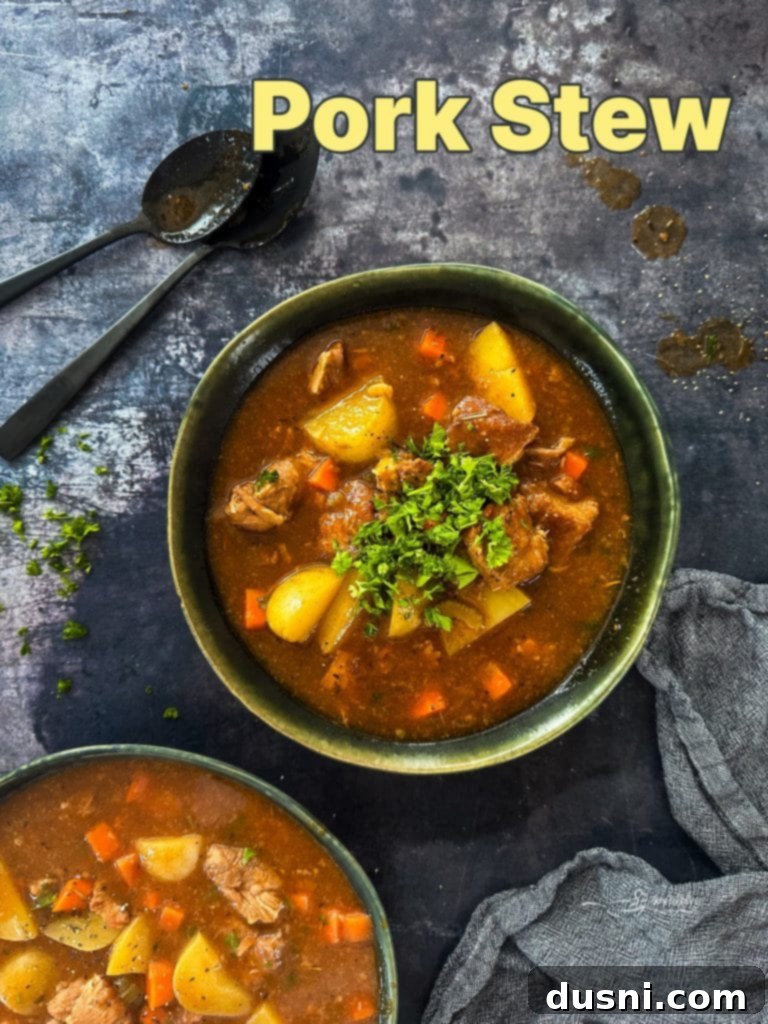
This hearty pork stew recipe is more than just a meal; it’s a culinary experience you’ll want to keep in your regular rotation, whether for cozy cold winter nights, festive family gatherings, or simply a comforting weeknight dinner. It’s packed with wholesome ingredients, features a deeply flavorful broth, and boasts juicy pork chunks that effortlessly fall apart after patient slow cooking. Beyond its deliciousness, this recipe proudly highlights the exceptional quality of Iowa pork and celebrates the unwavering dedication of the hardworking farmers who raise it with such care. Their commitment allows us to create these heartwarming, nourishing meals that not only satisfy our appetites but also bring comfort, connection, and a sense of tradition to our tables. Enjoy every delightful bite!

LIKE THIS RECIPE?
Don’t forget to give it a ⭐️⭐️⭐️⭐️⭐️ star rating and
leave a comment below the recipe!

Print Recipe
Pork Stew
Equipment
-
Lodge 6 Quart Enameled Cast Iron Dutch Oven. Classic Red Enamel Dutch Oven (Island Spice Red)
-
AmazonBasics Enameled Cast Iron Covered Dutch Oven, 6-Quart, Blue
Ingredients
- 4 slices thick cut bacon chopped into small pieces
- 1 (3 pound) boneless pork shoulder roast or Boston Pork Butt Roast fat trimmed and cut into 1.5” chunks
- 1 ½ teaspoons salt
- ¼ cup all-purpose flour
- 2 Tablespoons olive oil
- 1 (medium-sized) yellow onion diced
- 2 ribs celery diced
- 4 (medium-sized) carrots cut into chunks
- 4 cloves garlic minced
- 1 (8 ounce can) tomato sauce
- 2 bay leaves
- ½ teaspoon dried thyme
- 1 teaspoon paprika
- ½ teaspoon dried rosemary
- 6 cups vegetable stock
- 4 Yukon gold potatoes about 2 pounds, cut into chunks
- 2 Tablespoons cornstarch + 2 Tablespoons water combined to make a slurry
- Salt and Pepper to taste
- Fresh parsley chopped, for serving
Instructions
-
Add the bacon pieces to a large Dutch oven set over medium-high heat. Cook, stirring occasionally, until the bacon is crispy and the fat has rendered. Use a slotted spoon to transfer the bacon to a paper towel–lined plate, leaving the rendered fat in the pot.
-
Combine the flour and salt in a shallow dish, then dredge the pork pieces in the mixture to coat. Working in batches, add the coated pork to the pot with the reserved bacon fat and cook until browned on all sides. Transfer the browned pork to the plate with the bacon. Discard any remaining fat in the pot. Wipe the pot clean.
-
Pour the olive oil into the pot and set it over medium heat. When the oil is hot, add the onion and celery. Cook, stirring frequently, until the onion becomes translucent. Add the minced garlic and cook for about 1 minute, until fragrant. Stir in the tomato sauce, bay leaves, thyme, rosemary, and paprika.
-
Return the bacon and pork to the pot and pour in the stock. Bring the mixture to a boil over high heat, then reduce the heat to maintain a gentle simmer. Cover and cook, stirring occasionally, until the meat is very tender, about 1½ hours.
-
Uncover the pot and stir in the carrot and potato chunks. Cover again and continue cooking, stirring occasionally, until the vegetables are fork-tender, about 30 minutes. Remove and discard the bay leaves.
-
Stir the cornstarch slurry into the pot and cook for about 5 more minutes, until the stew has thickened.
-
Taste and adjust the seasoning with salt and pepper as needed.
-
Ladle into bowls and garnish with chopped parsley before serving.
Notes
Slow Cooker Instructions
- Brown the pork shoulder and bacon as you do with the stovetop method before adding to the slow cooker.
- Add the browned pork, bacon, and the rest of the ingredients, with the exception of the parsley, to the slow cooker.
- Cook on LOW for 7–8 hours or HIGH for 3½–4 hours, until the pork is fork-tender and the vegetables are cooked through.
- About 5 minutes before serving, stir in the cornstarch slurry to thicken the stew. Taste and season with salt and black pepper. Garnish with fresh parsley when serving.
Storage Tips for Leftovers
- Refrigerator: Let the stew cool, then store in an airtight container for up to 4 days.
- Freezer: Portion cooled stew into freezer-safe containers or bags, leaving room for expansion. Freeze for up to 3 months. Thaw overnight in the refrigerator before reheating.
- Reheating: Warm gently on the stove over medium heat, stirring occasionally. Add a little stock or water if the stew has thickened too much.
Nutrition
